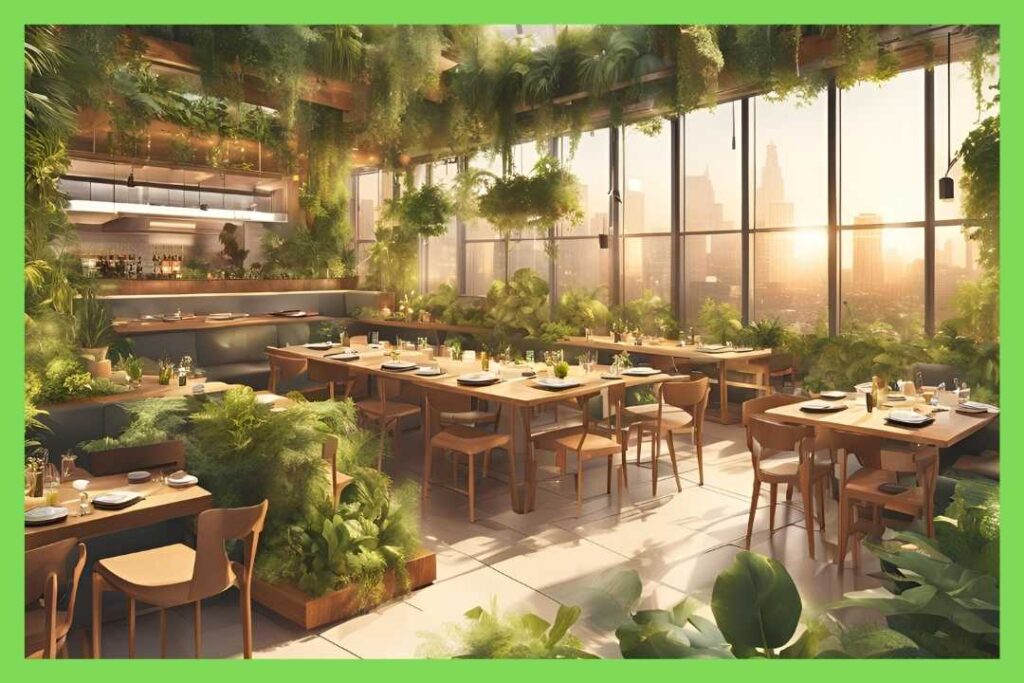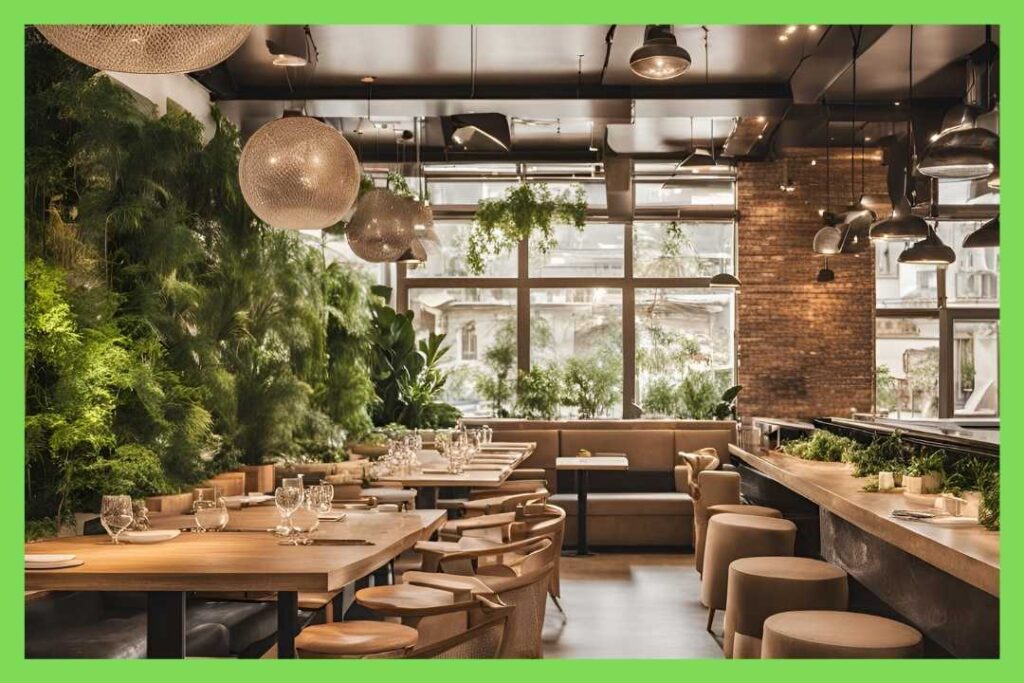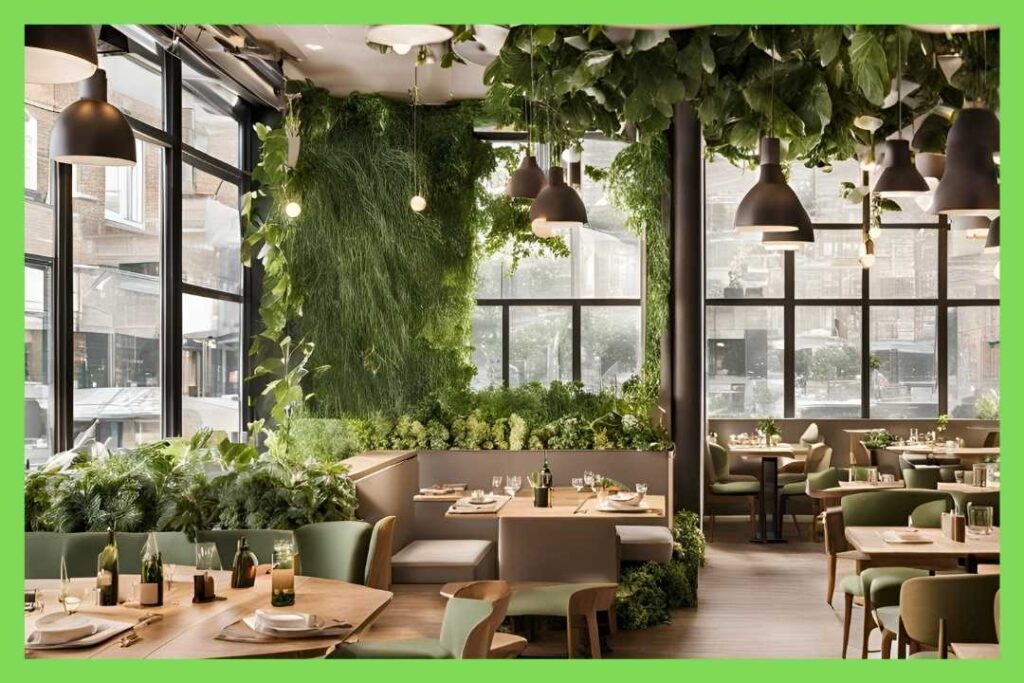In today’s world, people want to eat at places that care about the planet. They look for restaurants that are good for the environment and reduce waste. As we get closer to 2024, here are the top seven things that make a restaurant truly eco-friendly.
Restaurants that use renewable energy and have zero-waste plans are changing how we eat. Knowing these important features helps us choose the right places. This way, we support the green restaurants that are working towards a better future.
Embracing Sustainable Dining

Eco-friendly restaurants love using locally sourced, seasonal ingredients. They follow a farm-to-table approach. This means their menus have the freshest, most sustainable food available.
This choice is good for the environment. It also lets diners enjoy the unique tastes of the area.
Locally Sourced Ingredients
Eco-conscious restaurants focus on local ingredients. They do this to cut down on carbon emissions. By using food from nearby farms, they support local agriculture.
This approach also ensures the food is fresh and of high quality. It’s a win-win for everyone.
Farm-to-Table Cuisine
The farm-to-table movement is growing fast. More people want to eat at places that celebrate local food. Eco-friendly restaurants partner with nearby farms and producers.
This lets them create menus that show off the best of the season. It’s a way to enjoy a real, authentic meal.
“Embracing locally sourced, farm-to-table cuisine is not just a trend, but a fundamental shift towards a more sustainable and flavorful dining experience.”
Energy-Efficient Restaurant Operations

Eco-friendly restaurants focus on using less energy. They use new ideas and green energy to be leaders in sustainable dining. They install solar panels and choose energy-saving appliances to cut down on pollution.
Renewable Energy Sources
Eco-friendly restaurants use green energy to save energy. Many have solar panels to turn sunlight into electricity. This cuts down on fossil fuel use and shows their dedication to the planet.
Some restaurants also look into wind turbines or geothermal systems. This way, they get power from different sources. It makes their energy use both reliable and green.
| Renewable Energy Source | Advantages for Restaurants |
|---|---|
| Solar Panels | Reduced reliance on grid electricity, lower energy costs, and a smaller carbon footprint |
| Wind Turbines | Consistent and reliable power generation, particularly in areas with strong winds |
| Geothermal Systems | Highly efficient heating and cooling, reduced energy consumption, and long-term cost savings |
By choosing green energy, eco-friendly restaurants do good for the planet. They also show the way for others in the industry. This is what makes their dining experiences truly sustainable.
“Investing in renewable energy is not only the right thing to do for the planet, but it also makes good business sense. Our customers appreciate our commitment to sustainability, and it has helped us reduce our operating costs over the long term.”
– [Restaurant Owner Name], [Restaurant Name]
What Makes a Restaurant Truly Eco-Friendly
A truly eco-friendly restaurant does more than just look good. They take a deep dive into sustainability, making choices at every step. From building materials to waste management, they aim to cut down on carbon emissions and help the planet.
Using sustainable materials is a big part of being eco-friendly. Restaurants might choose bamboo, reclaimed wood, and energy-saving windows. They also focus on natural light and air, cutting down on energy use.
- Sustainable building materials, such as bamboo and reclaimed wood
- Energy-efficient windows and natural ventilation systems
- Renewable energy sources, like solar panels or wind turbines
But it’s not just about the building. Eco-friendly restaurants also have strong composting and recycling plans. They work with local farms and suppliers to cut down on transportation emissions. This helps the local economy too.
What really sets an eco-friendly restaurant apart is their all-in approach to sustainability. They make big efforts to lessen their environmental impact. This sets a good example for the industry and encourages others to be more sustainable. By doing so, they help create a healthier, greener future for everyone.
Zero-Waste Initiatives
Eco-friendly restaurants are at the forefront of the zero-waste movement. They work hard to cut down waste and keep materials out of landfills. These places find creative ways to reuse or upcycle items, showing their dedication to a greener future.
Plastic-Free Dining
Zero-waste restaurants focus on plastic-free dining. They’ve ditched single-use plastics like straws, utensils, and packaging for better options. This move encourages guests to live more sustainably by using reusable and compostable items.
Composting and Recycling Programs
These restaurants also have strong composting and recycling plans. They turn food waste and organic materials into compost for local gardens and farms. Their recycling efforts mean most of their waste is reused or repurposed, greatly reducing their environmental footprint.
| Zero-Waste Initiatives | Benefits |
|---|---|
| Plastic-Free Dining | Reduced plastic footprint, eco-friendly alternatives |
| Composting and Recycling Programs | Diversion of waste from landfills, nutrient-rich compost |
By taking on these zero-waste efforts, eco-friendly restaurants are setting a high bar for sustainable dining. They’re leading the way towards a more circular economy.
Environmentally Conscious Design

Creating eco-friendly eateries involves more than just food. The design and construction of the restaurant are key. Sustainable materials and energy-saving features are essential for restaurants that care about the planet.
Sustainable Building Materials
Eco-friendly restaurants use materials like reclaimed wood, recycled steel, and eco-friendly insulation. These choices cut down on carbon emissions and make the place look good. They appeal to diners who care about the environment.
Greenleaf Eatery is a great example. It built its dining area from reclaimed wood from old barns and warehouses. This approach adds charm and reduces the need for new wood.
Restaurants also use eco-friendly insulation, like sheep’s wool or recycled denim. These materials keep the place warm and are better for the planet than regular insulation.
By choosing sustainable materials, these eateries show they’re serious about being green. They offer a dining experience that matches the values of their eco-friendly customers.
Conclusion
In conclusion, a truly eco-friendly restaurant in 2024 is all about being sustainable. Places like Chez Panisse focus on local, seasonal ingredients. The French Laundry uses energy-efficient ways to cook.
Noma is a leader in zero-waste dining. These restaurants show they care about the planet. They work hard to reduce their environmental impact.
By eating at these places, we help the planet. We support the restaurant industry’s move towards being greener. This choice makes a big difference for our future.
As more people want to eat sustainably, these restaurants will lead the way. They will change how we enjoy food, making it better for everyone and the planet.
In the future, restaurants that succeed will mix great food with caring for the environment. They will set a new standard for being eco-friendly. This is what we can expect in 2024 and beyond.
FAQ
What makes a restaurant truly eco-friendly?
An eco-friendly restaurant focuses on being green in every way. They use local, seasonal food and save energy. They also use clean energy and try to waste nothing, like composting and recycling.
How can diners identify eco-friendly restaurants?
Look for restaurants that talk about being green. They should mention using local food, clean energy, and reducing waste. You can also check for green awards or certifications.
What are the benefits of dining at eco-friendly restaurants?
Eating at green restaurants is good for you and the planet. You get a tasty meal and help businesses be kinder to the earth. It’s a step towards a greener future.
How do eco-friendly restaurants differ from traditional establishments?
Green restaurants do more than usual. They use green building materials and save energy. They also focus on local food to cut down on carbon emissions.
What are some examples of eco-friendly restaurant practices?
Green restaurants use solar power and compost. They avoid single-use plastics and choose organic, local food. These steps help reduce waste and save resources.
How can restaurants become more eco-friendly?
Restaurants can go green by using efficient equipment and recycling. They should buy local and organic food and build with green materials. Teaching staff and customers about these efforts helps everyone get on board.
What are the long-term benefits of eco-friendly restaurant operations?
Green restaurants help the planet and save money. They attract customers who care about the environment. By being sustainable, they help their community and stay ahead in the business world.
